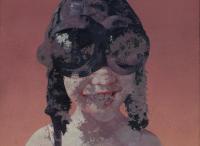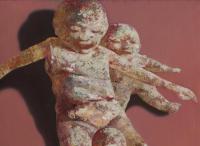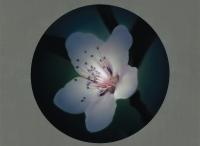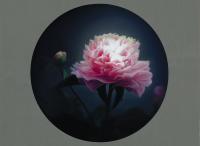THEME: PINK
 A toothy grin and great googly eyes. A child smiles at you, and the aviator's cap on her head is both absurd and whimsical, a joke the child knowingly shares with you the observer. Children are a frequent theme in Guo Jin's work, meditations upon pure joy and unadultered idealism. But against the context of modern China, the commentary takes on deeper, critical tones, asking if society's innocence has been lost or if naivety remains; if our worldview is youthful with its eyes full of opportunity, or blinded and obscurded by play-acting and make-believe.
A toothy grin and great googly eyes. A child smiles at you, and the aviator's cap on her head is both absurd and whimsical, a joke the child knowingly shares with you the observer. Children are a frequent theme in Guo Jin's work, meditations upon pure joy and unadultered idealism. But against the context of modern China, the commentary takes on deeper, critical tones, asking if society's innocence has been lost or if naivety remains; if our worldview is youthful with its eyes full of opportunity, or blinded and obscurded by play-acting and make-believe.
Click on the artwork for more information-
$35.00
 Children are a frequent theme in Guo Jin's work, meditations upon pure joy and unadultered idealism. Sliding captures a group of three moving with grace and abandon down an unseen slide behind them. Their movement is innocent, capturing a moment of play, but when the children are considered as stand-ins for something greater, whether that be society or the state of a country, the painting takes on greater complexities: does the downward slide imply loss or danger, and if so, what is the childrens' agency? Did they initate this descent, or plunge into it unwittingly? Guo Jin's work gives itself to many different readings, but the painting's sense of momentum and unknown potential remains constant.
Children are a frequent theme in Guo Jin's work, meditations upon pure joy and unadultered idealism. Sliding captures a group of three moving with grace and abandon down an unseen slide behind them. Their movement is innocent, capturing a moment of play, but when the children are considered as stand-ins for something greater, whether that be society or the state of a country, the painting takes on greater complexities: does the downward slide imply loss or danger, and if so, what is the childrens' agency? Did they initate this descent, or plunge into it unwittingly? Guo Jin's work gives itself to many different readings, but the painting's sense of momentum and unknown potential remains constant.
Click on the artwork for more information-
$35.00
 Yang Xun describes this portrait as “a peach blossom appearing from the dark like the scent of perfume left in the street; a visual sensation that reaches the viewer’s subconscious as a fragrance; a mood that gradually fills the air.” Yang’s Flower series was inspired by Song dynasty flower paintings on round fans. With brilliant light and soft shadow, he uses his subjects to portray multisensory memories of attraction, hope, pain, loneliness or despair.
Yang Xun describes this portrait as “a peach blossom appearing from the dark like the scent of perfume left in the street; a visual sensation that reaches the viewer’s subconscious as a fragrance; a mood that gradually fills the air.” Yang’s Flower series was inspired by Song dynasty flower paintings on round fans. With brilliant light and soft shadow, he uses his subjects to portray multisensory memories of attraction, hope, pain, loneliness or despair.
Click on the artwork for more information-
$35.00
 Chills on a Rainy Night depicts a cluster of pink blossoms against a nighttime backdrop. While the sky appears cold and overcast, a warm and unnatural light emanates from the pistil of the upward facing flower. Yang Xun describes this work as “the melancholy sight of peach blossoms on a rainy night, when long-forgotten memories can trigger a longing for someone who has disappeared from one’s life.” Yang’s Flowers series was inspired by Song dynasty flower paintings on round fans. With brilliant light and soft shadow, he uses his subjects to portray multisensory memories of attraction, hope, longing or despair.
Chills on a Rainy Night depicts a cluster of pink blossoms against a nighttime backdrop. While the sky appears cold and overcast, a warm and unnatural light emanates from the pistil of the upward facing flower. Yang Xun describes this work as “the melancholy sight of peach blossoms on a rainy night, when long-forgotten memories can trigger a longing for someone who has disappeared from one’s life.” Yang’s Flowers series was inspired by Song dynasty flower paintings on round fans. With brilliant light and soft shadow, he uses his subjects to portray multisensory memories of attraction, hope, longing or despair.
Click on the artwork for more information-
Available Soon
 Note: This artwork is not yet available for sale, but will be soon.
Note: This artwork is not yet available for sale, but will be soon.
The Compendium of Materia Medica refers to a 16th-century compendium of medicinal herbs, compiled by Li Shizhen, a Ming Dynasty botanist and pharmacologist. According to the Yang Xun, "Peony was described in the Compendium of Materia Medica as an unambiguously beneficial herb. This medicinal aspect is overlooked because of its exquisite flower; but underneath the ostentatious petals is a staid and reliable character."
Yang’s Flowers series was inspired by Song dynasty flower paintings on round fans. With brilliant light and soft shadow, he uses his subjects to portray multisensory memories of attraction, hope, longing or despair.
Click on the artwork for more information-
$35.00








